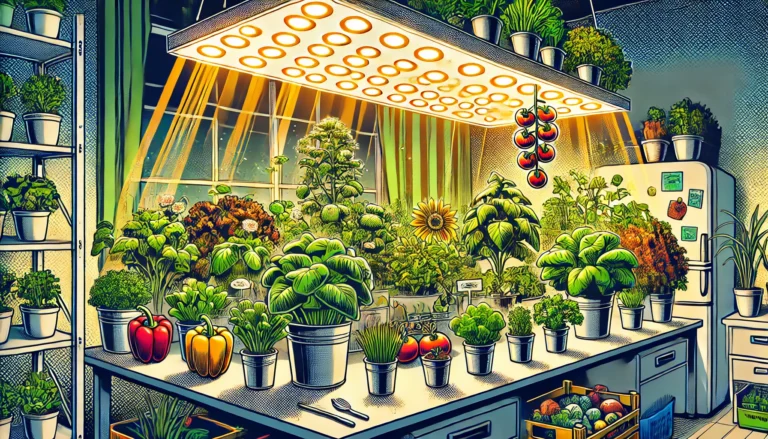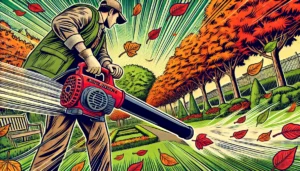Table of contents
Introduction
Are you ready to unlock the full potential of your indoor garden? Proper installation and maintenance of LED grow lights are critical for healthy plants and bountiful harvests. This guide simplifies the process, offering step-by-step instructions and practical advice for both beginners and seasoned gardeners.
In this article, you’ll learn:
- How to set up LED grow lights for optimal plant growth.
- Tips for adjusting light height and intensity at every growth stage.
- Maintenance techniques to ensure your lights perform at their best.
With the right approach, you can create a thriving indoor garden that’s efficient and sustainable. After you’ve got them mounted, you may want to compare different high-performance models — take a look at our guide to the best LED grow lights for indoor gardens.
Understanding LED Grow Lights
LED grow lights are a game-changer for indoor gardening, offering energy efficiency, long lifespan, and precise light spectrums. Before diving into installation, it’s essential to understand the basics.
Types of LED Grow Lights
Choosing the right type of LED grow light depends on your grow area and plant needs. Here’s a quick comparison:
| Type of LED Grow Light | Features | Best Uses |
| Panel Lights | Large coverage, even light distribution | Large grow areas, multiple plants |
| COB (Chip-on-Board) | High intensity, deep canopy penetration | Taller plants, fruiting/flowering |
| Bar Lights | Slim design, easily fits tight spaces | Vertical farming, shelf systems |
This table simplifies the selection process, helping you choose the best light for your setup.
To find the best LED grow lights for your indoor garden, check out our guide to the Best LED Grow Lights for Indoor Gardens in 2024.
Benefits of LED Grow Lights
- Energy Efficiency: Consume less power compared to traditional grow lights, reducing electricity bills.
- Customizable Spectrums: Tailored to plant needs, from germination to flowering stages.
- Low Heat Output: Reduces the risk of overheating your plants, ensuring better growth conditions.
- Longevity: LEDs last 50,000+ hours, providing consistent light over many growth cycles.
Safety Considerations
- Voltage Check: Ensure compatibility with your power supply to avoid electrical issues.
- Proper Handling: Avoid touching LEDs directly; oils from your hands can damage them.
- Ventilation Needs: Prevent heat buildup by maintaining proper airflow around the lights.
By understanding the types, benefits, and safety precautions, you’re prepared to choose the right LED grow lights for your setup. Next, we’ll explore how to prepare for installation.
For additional insights into how lighting affects plant growth, explore the University of Minnesota Extension’s Guide to Lighting for Indoor Plants.
Preparing for Installation
Proper preparation ensures your LED grow lights are installed efficiently and perform at their best. Follow these steps to get started.
Choosing the Right Space
- Ventilation: Ensure the area allows for good airflow to prevent heat buildup.
- Temperature Stability: Choose a space with a consistent temperature to avoid stressing plants or equipment.
- Height Availability: Make sure there’s enough vertical space to adjust light height as plants grow.
- Reflection Optimization: Use reflective walls (e.g., Mylar or white surfaces) to maximize light efficiency.
Gathering Materials
Before you begin, collect the necessary tools and equipment:
- LED Grow Lights: Ensure the lights are appropriate for your plants and grow area.
- Mounting Kit: Ceiling hooks, adjustable hangers, or a shelving unit.
- Timers and Power Strips: Automate light schedules and safely connect multiple lights.
- Measuring Tools: Tape measure for spacing and height adjustments.
Pre-Installation Checklist
Prepare your grow area and equipment with this simple checklist:
- Measure the Grow Area: Determine how many lights you need for full coverage.
- Verify Electrical Supply: Ensure outlets are compatible with the wattage and voltage requirements.
- Test Your Lights: Plug in and check for any defects or inconsistencies in brightness.
- Plan Light Placement: Sketch a layout to ensure even light distribution across the grow area.
Pro Tip: Calculating Light Coverage
Each LED grow light has a recommended coverage area. Use this formula:
- Coverage Area (sq. ft.) = Light Coverage Length x Width For example, a light with a 2×2 ft. coverage area works best for a single medium-sized plant or multiple smaller plants.
Before setting up your system, it’s worth making sure you’re choosing the right model for your space and growing goals.
Installing LED Grow Lights
Installing LED grow lights correctly ensures optimal performance and healthy plant growth. Follow these step-by-step instructions for a hassle-free setup.
Step-by-Step Installation Guide
- Unbox and Inspect the Lights:
- Check for any visible damage.
- Verify that all components, such as mounting brackets and cables, are included.
- Set Up Mounting Equipment:
- Choose a mounting method: ceiling hooks, adjustable rope hangers, or a shelving system.
- Attach mounting brackets securely to the lights, if required.
- Position the Lights:
- Place lights at the recommended height for your plants.
- Seedlings: 24–36 inches above the canopy.
- Vegetative Stage: 18–24 inches.
- Flowering Stage: 12–18 inches.
- Ensure even spacing for full coverage.
- Place lights at the recommended height for your plants.
- Connect to Power:
- Plug lights into a power strip with surge protection.
- Set timers for automatic on/off cycles (e.g., 16 hours on for vegetative growth).
- Test the Setup:
- Turn on the lights and check for even distribution.
- Look for any flickering or hotspots that might require adjustments.
Placement Tips
- Avoid Uneven Lighting: Overlapping light coverage improves uniformity and prevents shaded areas.
- Angle Adjustment: Tilt lights slightly if plants on the edges receive less light.
- Reflective Surfaces: Position lights close to reflective walls to amplify brightness.
Common Installation Mistakes
- Placing Lights Too Close: Can cause leaf burn and overheating.
- Ignoring Coverage Area: Leads to uneven growth if plants are outside the light’s range.
- Skipping Ventilation: Poor airflow can lead to heat buildup and reduced light efficiency.
By following these steps and tips, your LED grow lights will be properly installed and ready to nurture your plants. In the next section, you’ll learn how to adjust light height and intensity to match plant needs.
Adjusting Light Height and Intensity
Adjusting the height and intensity of your LED grow lights is crucial for optimal plant growth at different stages. Improper adjustments can lead to poor growth, leaf burn, or wasted energy.
Plant Growth Stages and Light Requirements
| Plant Stage | Height from Canopy | Recommended Light Intensity | Duration (Daily Light Hours) |
| Seedlings | 24–36 inches | Low to moderate intensity (30-50% power) | 16–18 hours |
| Vegetative Stage | 18–24 inches | Moderate to high intensity (50-75% power) | 16–18 hours |
| Flowering/Fruiting | 12–18 inches | High intensity (75-100% power) | 12–14 hours |
How to Adjust Light Height
- Monitor Plant Response:
- If leaves curl upward or turn brown, the light is too close.
- If plants appear stretched or leggy, the light is too far.
- Use Adjustable Hangers:
- Invest in rope ratchet hangers to easily raise or lower the lights.
- Measure Regularly:
- Use a tape measure to maintain consistent height as plants grow.
Using a PAR Meter
- A PAR Meter measures Photosynthetically Active Radiation, helping ensure plants receive the optimal amount of usable light.
- Target ranges:
- Seedlings: 200–400 µmol/m²/s.
- Vegetative Stage: 400–600 µmol/m²/s.
- Flowering/Fruiting: 600–900 µmol/m²/s.
Light Intensity Adjustment Tips
- Dimmable Lights: Adjust brightness with the built-in dimmer switch, if available, to prevent overheating sensitive plants.
- Cycle Optimization: Match light schedules to the plant’s natural growth cycles for maximum efficiency.
- Avoid Overexposure: More light isn’t always better—ensure dark periods for plant recovery.
Troubleshooting Light Height Issues
- Leaf Burn: Raise the lights immediately if leaves show scorch marks.
- Stretching Plants: Lower the lights or increase intensity to prevent weak, leggy growth.
- Uneven Growth: Rotate plants or adjust light placement to ensure even exposure.
Properly adjusting light height and intensity will ensure your plants thrive at every growth stage. The next section will focus on maintaining your LED grow lights for long-term performance.
Maintaining LED Grow Lights
Regular maintenance keeps your LED grow lights performing at their best, ensuring consistent plant growth and a long lifespan for your equipment. Follow these maintenance practices to avoid common issues and extend the life of your lights.
Routine Cleaning
- Dust and Debris Removal:
- Gently clean light diodes and lenses with a microfiber cloth.
- Use compressed air to remove dust from hard-to-reach areas.
- Avoid Abrasive Cleaners:
- Use a soft, damp cloth with water or a non-abrasive cleaning solution to prevent scratches.
Inspecting Components
- Check for Loose Wires:
- Inspect power cords and connections for fraying or looseness.
- Monitor Cooling Systems:
- Clean fans or heat sinks regularly to prevent overheating.
- Look for Damaged Diodes:
- Replace any non-functioning LEDs to maintain light intensity and spectrum balance.
Calibrating Timers
- Adjust timers seasonally or as plant growth cycles change.
- Ensure timers function properly by testing them weekly to avoid interruptions in light schedules.
Troubleshooting Common Issues
| Problem | Cause | Solution |
| Flickering Lights | Loose connections or power fluctuations | Tighten connections, check voltage |
| Uneven Light Distribution | Dust buildup or damaged diodes | Clean lenses, replace diodes |
| Excessive Heat | Blocked ventilation or dirty cooling fans | Clean fans, ensure proper airflow |
Pro Tips for Long-Term Maintenance
- Keep a Maintenance Schedule:
- Clean and inspect your lights monthly for consistent performance.
- Store Lights Properly:
- During off-seasons, store lights in a cool, dry place to avoid moisture damage.
- Replace Components When Needed:
- Replace parts like hanging kits, timers, or power cords if they show wear and tear.
By following these simple maintenance steps, you’ll ensure your LED grow lights stay in peak condition, providing your plants with reliable, effective lighting. In the final section, we’ll recap key points and share additional resources for your indoor gardening journey.
Pro Tips for Longevity
Maximizing the lifespan of your LED grow lights not only saves money but also ensures consistent, high-quality lighting for your plants. Here are some practical tips to keep your setup running smoothly for years to come.
Energy-Saving Tips
- Use Timers or Smart Plugs:
- Automate on/off cycles to optimize energy usage and prevent overexposure.
- Adjust Lighting for Growth Stages:
- Dim lights or reduce daily hours during early growth stages to save energy without compromising plant health.
Optimize Placement
- Avoid Overlapping Heat Sources:
- Space lights apart to prevent overheating and reduce strain on cooling systems.
- Use Reflective Surfaces:
- Enhance light efficiency by positioning grow lights near reflective materials like Mylar.
Protect Your Investment
- Prevent Power Surges:
- Use surge protectors to shield your lights from electrical damage.
- Regular Cleaning:
- Dust buildup reduces light output and heats up components, shortening the light’s lifespan.
Storage Recommendations
- Disassemble Carefully:
- Detach mounting brackets and power cords to prevent damage during storage.
- Choose a Dry Location:
- Store lights in a cool, moisture-free environment to avoid corrosion or electrical issues.
When to Replace Components
- Signs of Wear:
- Replace parts like adjustable hangers, fans, or power cords if they show signs of fraying or malfunction.
- Diminished Light Output:
- If plant growth slows despite proper use, consider replacing older diodes or upgrading to newer technology.
Eco-Friendly Disposal
- Recycle Old LEDs:
- Many components can be recycled. Contact local recycling programs to dispose of old grow lights responsibly.
By implementing these tips, you’ll get the most out of your LED grow lights, ensuring a sustainable and efficient indoor gardening experience. Ready to recap everything you’ve learned? Let’s summarize the key points and explore further resources in the conclusion.
Conclusion
Proper installation and maintenance of LED grow lights are essential for a thriving indoor garden. With the steps and tips outlined in this guide, you can ensure your plants receive the best possible care while maximizing the efficiency and lifespan of your equipment.
Key Takeaways
- Installing LED Grow Lights:
- Choose the right type of light for your plants and space.
- Follow the proper mounting and positioning techniques for even coverage.
- Adjust light height and intensity based on plant growth stages.
- Maintaining LED Grow Lights:
- Clean diodes and lenses regularly to maintain light efficiency.
- Inspect and troubleshoot components to avoid performance issues.
- Use timers, protective measures, and proper storage to extend light longevity.
- Pro Tips:
- Optimize energy use with timers and dimmers.
- Store lights safely during the off-season to prevent damage.
- Recycle old lights responsibly when upgrading or replacing.
Next Steps
Explore more resources to enhance your indoor gardening setup:
- Best LED Grow Lights for Different Types of Plants: Discover tailored recommendations for various plant types.
- DIY Hydroponics Guide: Learn how to integrate hydroponic systems with LED grow lights.
- Indoor Plant Care Tips: Keep your plants healthy year-round with expert advice.
LED grow lights are an investment in your indoor garden’s success. With the knowledge from this guide, you’re now equipped to create an efficient and sustainable setup that supports lush, productive plants. Have questions or tips to share? Join the conversation in the comments below!





